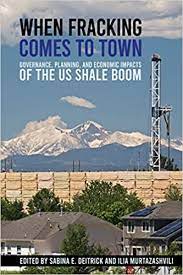From an Article & Interview by Kara Holsopple, Allegheny Front, April 18, 2022
Since the industry came to Pennsylvania almost 15 years ago, fracking has been looked at from a lot of angles — economic, environmental, and even geopolitical. But Sabina Deitrick, an associate professor at the Graduate School of Public and International Affairs at the University of Pittsburgh, and her colleague, Ilia Murtazashvili, noticed a hole.
“We were finding there wasn’t a lot for planners in our municipalities, for supervisors,” Deitrick said. “Volunteers were making decisions on things that had to do with fracking – not pro-fracking or anti-fracking – but what was happening in their town or their township or their borough. We were finding that there wasn’t a lot of advice and a lot of information from the state.”
So they put out a call to colleagues for a workshop on the impacts of fracking from the perspective of local government. It became the basis for the book: When Fracking Comes to Town: Governance, Planning, and Economic Impacts of the US Shale Boom.
The Allegheny Front’s Kara Holsopple spoke with Sabina Deitrick about some of the themes in the book:
>>> “That boom was happening, but there are ways that public officials could address parts of the boom so that it didn’t create the most deleterious effects of the bust.“
>>> “[D]espite the known risks and negative impacts on health and environment…for local officials, bringing outside money into their communities for many of them is one of the most important reasons for fracking.”
>>> “For places to mitigate the worst of the downside of [fracking]…some new coalitions [can be] formed in working with communities that are already successful in mitigating the worst effects of the boom-bust cycle.”
“I think that our conclusions are really for folks to recognize that for many opponents of fracking, the health side and the environment side should be enough for them to think about how other places might want to ban fracking. But thinking about local officials, thinking about communities, thinking about revenue streams, and thinking about how that community is trying to promote quality of life becomes important.”
“For places to mitigate the worst of the downside of these is important, and that’s where I think there can be some new coalitions formed in working with communities that are already successful in mitigating the worst effects of the boom-bust cycle.”
“That might be a place for a lot of folks to start or for other places that aren’t quite as advanced on capacity building. In that way, through peer-to-peer learning and through things that local communities, particularly in Marcellus, learned through those kinds of interactions and that didn’t come from state officials.”
### ~ Sabina Deitrick is an associate professor at the Graduate School of Public and International Affairs at the University of Pittsburgh. She’s co-director of the Urban and Regional Program at the University Center for Social and Urban Research, and she co-edited the book When Fracking Comes to Town: Governance, Planning and Economic Impacts of the US Shale Boom [Cornell University Press.]
>>>>>>>…………………>>>>>>>…………………>>>>>>>
Concerned Ohio River Residents (CORR)
Ohio Valley citizens are concerned about the extremely detrimental toll that the petrochemical and oil & natural gas industries will take on our health, air, water and future. We’re organizing to protect our beautiful Ohio Valley from these toxic polluters. We are dedicated to informing the public about the industries’ projects and the plethora of negative effects they bring with them. We also want to provide the tools and connections needed to get involved. We are supported by partner grassroots organizations – national and local.


{ 2 comments… read them below or add one }
COMMENT ON THE ANALYSIS IN THE BOOK
The cover art of this book has a deceptive picture of a frac well not the hell on earth reality.
Generally, there has been a lack of governance. Combine this with a lack of enforcement of existing laws. And, there has been more money under the table than has been described.
Actually, sickness and in some cases deaths have resulted. Not at all a pretty picture to be permitted for a few hundred thousand dollars.
marilyn hunt
“THE LAND REMAINS” as The Back Forty has a life of its own ….
In my new book, I lets the land speak for itself, says Neil Hamilton …
Who speaks for the land in Iowa? Mostly, the loudest voices come from large, powerful agricultural interests who see the land as a resource to exploit while paying little more than lip service to the notion of conserving and protecting the land for future generations.
But in a new book by retired Drake Law Professor Neil Hamilton, the land speaks for itself.
Throughout “The Land Remains,” a tract of Adams County farmland where Hamilton grew up, “The Back Forty,” talks about its history and chronicles the many changes in agriculture and public policy that have shaped its existence.
“For much of these thousands of years my only company was the animals and birds, the reptiles and others who found their homes nestled in my grasses or burrowed into my soils. Periodically, the tranquillity they found would be interrupted by the footsteps of humans,” The Back Forty recalls in its first appearance in Hamilton’s book.
As someone who has interviewed the Cedar River a couple of times, I’m a big fan of The Back Forty.
Wrapped around the land’s reflections are Hamilton’s experiences as a farm kid, landowner, policy advocate and agricultural law professor. He’s one of the state’s clearest, most experienced voices on agricultural policies and the pressing need for improved environmental stewardship. His book is a sweeping recounting of the conservation efforts, controversies and failures that have shaped the land and the state’s serious environmental problems.
https://www.thegazette.com/staff-columnists/in-his-new-book-neil-hamilton-lets-the-land-speak-for-itself/